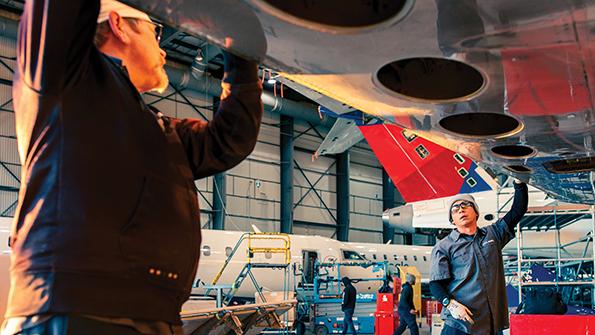
MHIRJ’s 30 maintenance lines are staying busy even amid regional
airline sector upheaval.
The growth prospects for the regional airline industry may look shaky, but the market is not going away anytime soon. That spells opportunity for aftermarket providers, including companies better known for building products than supporting them.
Both Embraer and MHIRJ, the Mitsubishi Heavy Industries arm that bought Bombardier’s legacy Canadair Regional Jet (CRJ) program in 2020, are broadening their offerings. Their goals are similar: nurture a broad enough set of services to establish themselves as reliable, agnostic after-market providers.
“We’d like to be known as an aftermarket services company, and not the CRJ company,” Ross Mitchell, MHIRJ vice president for strategy and business development, tells Aviation Week.
- Regional aircraft manufacturers add capacity and support
- Component work is an important focus
- Airframe maintenance remains robust
The company has focused largely on supporting the Bombardier regional jet fleet for which it assumed responsibility via the 2020 purchase. Demand is strong, but with the CRJ out of production, the fleet is not growing. Moreover, airlines have been parking single-class, 50-seat variants in favor of larger two-class models, in part due to a shortage of qualified pilots.
In response, MHIRJ is diversifying. Its components business is taking off. It has gained two customers for Embraer ERJ 145 heavy maintenance, including a just-announced three-year deal with Piedmont Airlines.
Its most recent move takes it out of the regional space completely. MHIRJ has added mobile repair capability for the Airbus A220—the first step in a ramp-up that the company envisions leading to full airframe heavy maintenance work.
Adding the A220 “allows us to continue to grow the business beyond the base,” Mitchell says. “The base of the business was the CRJ. We’re moving beyond the CRJ, and the A220 is beyond the regional space, which is quite important.”
If all goes as planned, MHIRJ’s Bridgeport, West Virginia, facility—with 17 maintenance lines, including six added last year—is to begin welcoming A220s for unscheduled airframe work by year-end, says Ismail Mokabel, senior vice president and head of aftermarket. Scheduled A220 checks would start in 2024.
“We start with a mobile repair team, where the customer need is now,” Mokabel says. “Then by the end of this year, we should be supporting unscheduled events in our shops, and then [pursue] our aspiration to be a heavy maintenance, fully spooled-up organization.”
Like its legacy Bombardier and blossoming Embraer regional airframe businesses, the A220 airframe offering is planned to target North American operators. It also could hint at what is to come as MHIRJ broadens its aftermarket capabilities. Larger platforms are among the possibilities, as both Bridgeport and the company’s 13-line Tucson, Arizona, shop can accommodate airframes larger than the A220, Mokabel notes.
Meanwhile, Embraer is adding capacity to meet strong demand while looking beyond its product line for growth. With its two U.S. heavy maintenance facilities all but sold out through 2024, the company is poised to expand at its largest base in Nashville, Tennessee.
“We know our customers in North America really like our facility in Nashville,” Frank Stevens, global vice president for MRO services, said during a recent media event at the shop. “We are looking at expanding there because we’re at nine lines, and we’re sold out through 2024.”
The appeal of Embraer Aircraft Maintenance Services’ (EAMS) Nashville facility stems from multiple factors, Stevens noted. The airport is a natural termination point for several customers that serve the city. It also has ancillary services, as well as a 50,000-ft.2 component shop in La Vergne, just outside Nashville, that handles large composite structures, flight controls and other parts.
Nashville’s nine maintenance bays are all dedicated to heavy-check work. One bay had been reserved for drop-in work or unscheduled events. But demand for heavy work, including leased aircraft transitioning to new operators, convinced Embraer to use every available bay.
Its other U.S. heavy-check shop, in Macon, Georgia, has six lines and is nearly as busy. “We can probably put one or two more airplanes in there, and then we’re full through 2024,” Stevens said.
After several tumultuous years that included a near-tie-up with Boeing, delays in its E175-E2 program and the pandemic, Embraer is seeking more solid ground. A five-year plan focuses on growing core products and capabilities while betting heavily on urban air mobility with its Eve affiliate.
Its services business, created in 2016, is part of the company’s core—and one of its bright spots. Catering to business aviation and military customers as well as airlines, it grew 12% last year to about $1.3 billion, representing 28% of company revenues. The services division operated with only about 2,300 employees, or 13% of the company’s 18,000-strong workforce.
“And we are growing,” says Danielle Vardaro, Embraer vice president for worldwide customer support and aftermarket sales.
Airframe maintenance demand is constrained by capacity. But component work and related services such as power-by-the-hour deals, where operators share spare parts pools, are helping services grow. Only about 10% of the work at La Vergne supports Embraer’s heavy-check business—the rest serves external customers.
Demand for more heavy-check work is there, and Embraer plans to tap it. The company says it has captured about 70% of the North American market for legacy E170- and E190-series work. Another 15% is done by customers themselves. That leaves 15% that is contracted out to non-Embraer facilities. “We know exactly what our target is,” says EAMS Commercial Director Neal Reagor.
In the meantime, Embraer is increasing efficiency to help create capacity. Nashville is on the verge of going completely digital on the shop floor, from importing documents and PDFs provided by customers to having electronic signoffs.
With EmpowerMX’s FleetCycle software, all nonroutine work is already digital; a trial in the coming weeks will validate the process for routine work, says Jason Grafton, Embraer MRO Commercial’s chief operating officer and managing director. “We are doing proof of concept in April and hope to have whole rollout in July,” he says.
